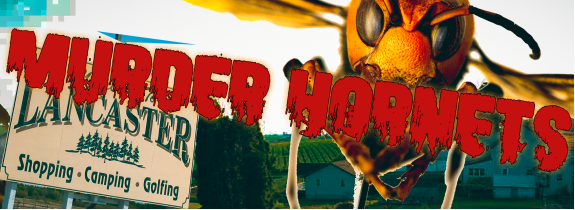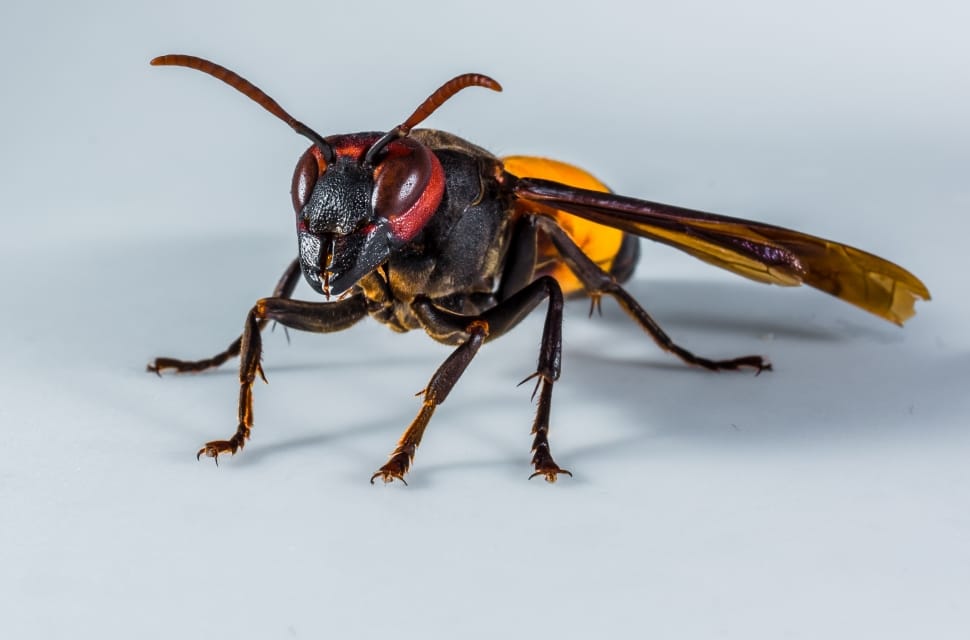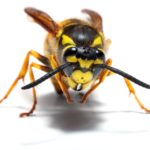
Are Murder Hornets Teaming up with Lanternflies and Stink Bugs to Ruin Your BBQ?
July 10, 2020They’re giant!
They decapitate!
They’re invasive!
No wonder there’s fear lingering over whether Murder Hornets are coming to Pennsylvania.
As the world’s largest hornets, Murder Hornets, also called Asian Giant Hornets (Vespa mandarinia) are common in many parts of Asia.
These murderous insects are a threat to honeybees since they kill the bees as food for their young. Asian Giant Hornets decapitate the bees (as well as beetles and yellowjackets) and then carry the carcasses back to their larvae for nourishment.
Check out this video of some bees getting their revenge!
Although the Washington State Department of Agriculture confirmed Murder Hornet specimens were found in the Pacific Northwest, there’s been no invasion confirmed and no sightings reported beyond that.
They’re Just Hornets

Chris Looney, the Washington Agriculture Department entomologist who gained fame when reports about Asian Giant Hornets first surfaced, said they are not “Murder Hornets” since the number of humans stung is very small. Asian Giant Hornets do have huge stingers that can inject a strong venom; however, their sting is not likely to cause death in humans.
We obtained a specimen of a Murder Hornet to study and to educate our staff in the event the Asian Giant Hornets would expand to other states and end up an invasive species in Pennsylvania.
Check out this 3-D version below of the Asian Giant Hornet (please wait 45-60 seconds for it to fully load). Would you like to download and 3D-print your own Murder Hornet? Click Here
For now, your BBQ, picnic, and overall summer activities should be safe from the threat of this fascinating insect. Yet there are wasps with a similar appearance here in Pennsylvania that you’ll want to avoid.
Murder Hornet Lookalikes are Here
European Hornets are about the same size as Asian Giant Hornets (Murder Hornets) and are on the rise here locally. Another insect, the large solitary wasp called the cicada killer is common to Pennsylvania and may have you thinking you’ve spotted a Murder Hornet. A recent news report from Ephrata (Washington) revealed that several local residents mistook a Western Cicada Killer as an Asian Giant Hornet.
At first, it’s easy to get these insects confused since their coloring is similar. Since they’re all large, winged creatures that appear to sting, fear can play a role in your confusion too.
European Hornet

A European Hornet can range in size from 2 inches to 3.5 inches. This hornet has a reddish-brown head that gradates to yellow near its face, while the Asian Giant Hornet will have a nearly all yellow head and face.
The European Hornet preys on grasshoppers, flies, and bees and they prefer to nest in tree cavities, attics, barns, outside wall fixtures or lighting, and other spaces off the ground. They are social insects so the form large hives. They will strike multiple times if disturbed.
Giant Cicada Killer Wasps
You might mistake Giant Cicada Killers as murder hornets. Giant Cicada Killers range in size from 1 to 1.5 inches. Both males and females are colored black, red, and yellow. Their heads are mostly red.
The male Giant Cicada Killer cannot sting, and the female Giant Cicada Killer is only interested in stinging cicadas, which they use to incubate and nourish their eggs. Although they pose little threat for stinging, they are a nuisance in that they will aggressively defend their ground nests by buzzing closely to humans. Their ground nests are unsightly and can damage lawns.

Wait, is a Hornet a Wasp?
Hornets are a subset of the wasp family. Hornets are larger than wasps. Yellowjackets, often mistaken for honeybees because they are similar in size and color, are actually wasps. Wasps eat insects and bees “eat” nectar. Hornets have black and white rings on their bodies while wasps have black and yellow rings.
Typically, a hornet will be less aggressive than a wasp, yet their sting is more painful to humans. Lastly, a hornet will lay its eggs in an elevated nest while a wasp will lay its eggs in the body of other organisms.